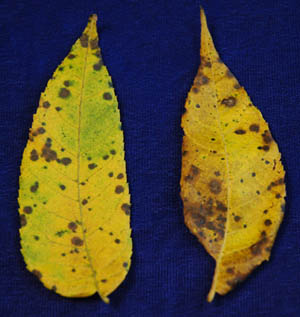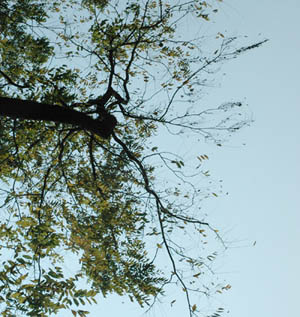Walnut Anthracnose | |
|---|---|
| September 26, 2007 | |
|
Black walnut trees experiencing premature defoliation may be suffering from an anthracnose disease. Black walnut (Juglans nigra), butternut (J. cinerea), and other species of Juglans are susceptible. Anthracnose is a general term used to refer to diseases caused by fungi that produce spores in specific fruiting structures called acervuli. In the case of Juglans spp., anthracnose is caused by the fungus Gnomonia leptostyla. This is not the same fungus that causes anthracnose on sycamore, oaks, ash, and other shade trees. The primary symptom on black walnut is circular brown lesions on the leaves. While first visible only on the underside of the leaf, lesions eventually can be seen on both upper and lower leaf surfaces. The spots range in size from tiny pinpoints up to 5 mm in diameter.  Later symptoms include yellowing of the leaves, marginal browning, and casting of leaflets, all visible now on moderately susceptible trees. Temperature and moisture are the most important factors in disease development. In wet seasons, infected walnut tress may defoliate by late July or August. In addition to infecting the leaves, this fungus may also infect petioles, rachises, twigs, and fruit. Affected trees often drop their fruit prematurely or produce nuts with dark, shriveled meat. While obviously a concern for nut producers, this disease most often does not cause long-term harm to the tree in the residential landscape and does not require control measures. However, trees experiencing consecutive years of early defoliation may be seriously weakened. Defoliation that occurs after the tree has completed its growth for the season is not a serious concern. The image shows thinning of foliage on an affected limb late in the season.  The walnut anthracnose fungus primarily overwinters in fallen leaves but may also survive in infected fruit and twig lesions. During favorable weather conditions in the spring, spores germinate and are disseminated to new foliage by wind and rain. With ample moisture, germinated spores infect the new leaves, and the disease cycle begins. Asexual spores of this fungus are released from the new lesions and continue to infect new sites throughout the tree. Logically, raking and removal of infected leaves and fruit is the most effective way to reduce future infections. Do this as a normal part of fall cleanup. Root-zone applications of nitrogen fertilizers in spring have demonstrated enhanced growth and reduced disease severity. (Shanyn Siegel, Plant Clinic diagnostician) �� | |
| Author: | Nancy Pataky |
